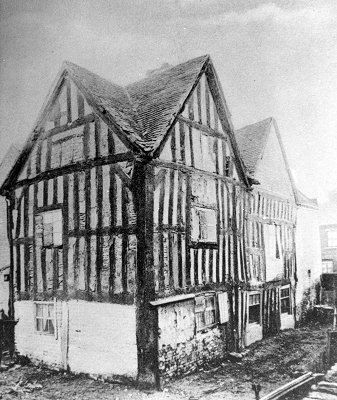 |
A History of BilstonSeventeenth Century Bilston |
|
The next picture is of Bilston in the seventeenth century. G. T.Lawley wrote the following description of his native town at that time:
"The village consisted of one long street and a few quaint off shoots in which ancient half-timbered mansions, tiny Noah's Ark like cottages, and a few three story structures of a more modern type were jumbled together with a Philistinic contempt of street line and regularity, for some of them pushed their broad shoulders across the footpath and resolutely refused to budge until the increase of population and vehicular traffic rendered their truculent obtrusiveness unbearable. In the gaps between the houses of which there were many, cornfields and orchards surged like an inundation, in whose green shadows the village nestled snugly:"Surrounding the village at a respectful distance, the Sedgley Beacon, the Rowley Hills, the hill fortress of Wednesbury, the lofty Barr Beacon and the high ground of Cannock made an attractive girdle for the softer and more pastoral features of the landscape. These consisted of leafy woods and blossoming hedgerows, cornfields and meadowlands dotted here and there with well built farmhouses half hidden in their own gardens and orchards. Through this scene flowed two sparkling brooks, guiltless yet of pollution. Springing from their sources at the foot of the Beacon Hill three miles away they meandered slowly northwards to the river Tame.
"Clumps of mighty Oaks and Beeches, Ashes and ancient Hawthorns - remnants of the great forest of Cannock, that once formed the eastern boundary of the Parish, which still stood sturdy and vigorous, beneath whose sheltering branches the farmer's swine found rich pasturage without paying pannage and other dues.
"The corn grown was ground in the village windmill which stood in congenial surroundings of wood and meadow in what was then called the Upper Field at the extreme edge of the village which still bears the name of Millfields.
"Flax was not only grown but it was "beaten" and "shredded" and "tutored" in the village. "Hot chilling" houses and spun and woven into garments both bleached and unbleached. The Churchwardens saw to it that the poorer housewives were provided with "Wheels" and "Spindles" and "Carding boards".
"Here and there in the middle of buttercup meadows could be seen a hand windlass of the most primitive construction, where coal which had been raised in the Parish as far back as the eighth century was being obtained in a most leisurely way for the purpose of supplying fuel for domestic purposes."
 |
This old photo shows the Greyhound and Punchbowl Inn before restoration. It was originally built in the mid 16th century |